SANSHIRO SUGATA told a complete story and didn’t need a sequel. But, it was popular
and the war office wanted a propaganda film to inspire the audience as Americans pushed towards the island nation, so Kurosawa complied, albeit without much interest. The result is widely regarded as one of Kurosawa’s worst films.
The film is split into two narratives with the first part largely focusing on brutal Americans vs. the soulful, noble Sugata. A drunken American sailor assaults a lowly rickshaw driver after a mishap and Sugata steps in to stop the abuse. The sailor is a boorish, ugly stereotype and Sugata is the Japanese champion. The result is that the sailor ends up in the water as a callback to the opening fight of the earlier film.
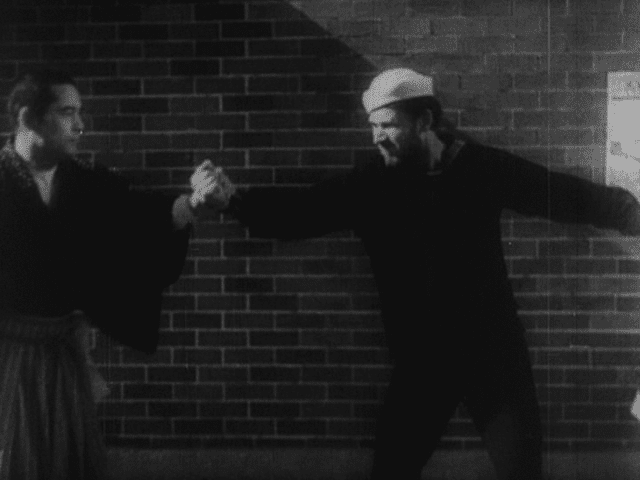
What’s most shocking about SANSHIRO SUGATA PART 2’s opening scene is not that it’s propaganda, but that it’s so badly shot. The sequence consists of nothing but long and mid-range shots, the editing has no edge, extras mug in the background, and the fight is just not exciting. I don’t know if it was disinterest on Kurosawa’s part or a rushed effort for a variety of reasons, war, budget, deadline, etc., but the result is amateur hour.
The rest of the first part of the film is better shot, but no more interesting. As in many sequels where the main character already has grown, Sanshiro Sugata has his character development turned back at least one step for unconvincing reasons. Where once he was confident and at peace, he’s now unsure about his role in the world again.
The Ambassador to the American embassy, a western dressed fop, asks Sugata to partake in a match pitting American boxing vs. judo. Sugata declines as judo for entertainment goes against his core tenets. However, he’s curious to see what boxing is and goes to observe.
At the boxing match, Kurosawa engages in some pretty blatant stereotyping (likely at the war office’s insistence). The American men are ugly cigar smoking caricatures or drunken sailors. The women are all blondes. And they’re all cheering the boxing match because of its brutality. Now, the stereotypes don’t bother me, after all there are plenty of Japanese stereotypes in Hollywood movies of the period, but the sequence is flat and uninvolving.
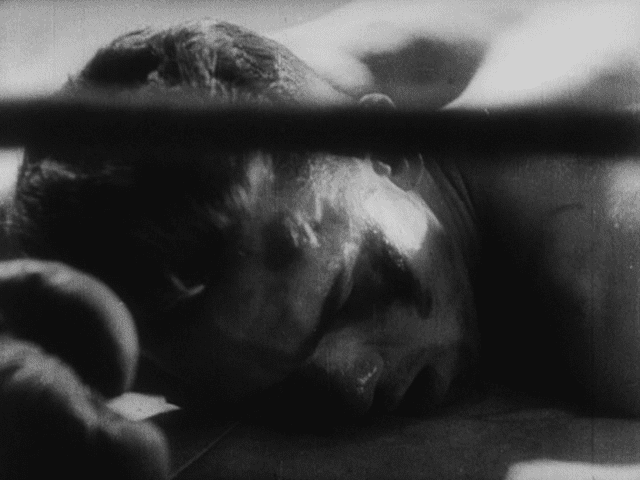
Sugata is disgusted by the brutality. He tries to talk the jujitsu fighter pitted against the American champion out of the bout for the respect of Japanese martial arts. The jujitsu fighter replies that Sugata’s judo has destroyed Japanese martial arts for the rest and that he needs the money to survive. Afterwards, Sugata leaves the match with his internal turmoil evident.
The first part of the movie is pretty much a wash. But, Kurosawa was too much of a pro to make a complete waste of film and the film begins to gather momentum and style. Sugata retreats back to the dojo and the tutelage of Yano (Denjiro Ookouchi ). The beaten rickshaw driver comes to be Sugata’s pupil and there’s a very nice montage of the driver coming in and bowing at the mat and in each iterations showing more confidence and presumably skill, which very cleverly and efficiently shows Kurosawa’s growing skills. It’s a brilliant sidestep of the training montage. Even in a movie that no one counts among his best, you can see evidence of Kurosawa’s genius.
The plot picks up more as the film moves on to a revenge scheme by the brothers of the first film’s villain Gennosuke Higaki (Ryunosuke Tsukigata). Tesshin Higaki (Ryunosuke Tsukigata in a dual role) and Gunzaburo Higake (Akitake Kono) disrespectfully enter the dojo and challenge Sugata to a duel to determine the superiority of karate to judo. Sugata refuses and the pair starts attacking judo students at night, pressing the issue. Tesshin is fairly one dimensional, but Gunzaburo is an interesting character. He’s clearly crazy with long, wild hair. He’s also a character out of the Noh tradition, carrying a bamboo twig which is the traditional symbol of craziness. He’s also an epileptic that suffers violent fits. He’s a memorable character.
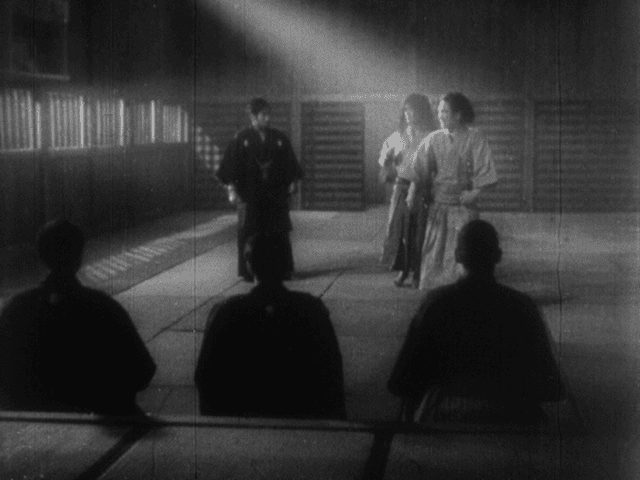
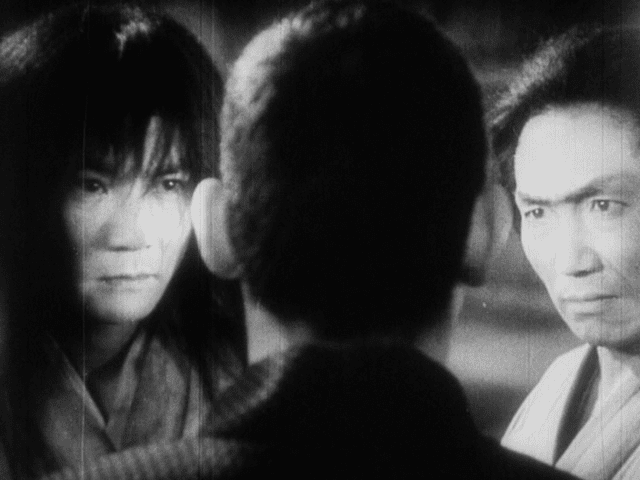
It’s here that Kurosawa finally steps out of the shadow of the earlier film and gives the sequel a bit of meaning. Between films, Gennosuke Higaki has reacted to his defeat by finding peace and meaning. Instead of a one dimensional villain, he’s found the path that Sugata has lost. He’s also dying, Kurosawa doesn’t spell it out, but it certainly looks like
he’s afflicted with TB. Gennosuke tries to talk his brothers out of their revenge scheme in a fun bit of dual role camera trickery and editing. When that fails, he delivers the secrets of karate to Sugata hoping that Sugata will win being the more worthy person to advance Japanese martial arts.
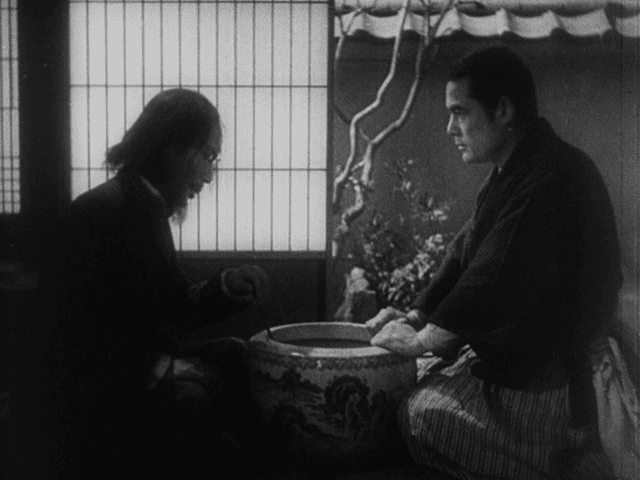
Sugata is genuinely touched by this conversion. Even offering to ferry Gennosuke back to his home in a rickshaw, which may be Gennosuke’s last chance to see the city. An encounter with Sanshiro’s erstwhile love interest from the first movie, Sayo (Yukiko Todoroki), also Gennosuke’s former love, causes Gennosuke to painfully button up the rickshaw and depart. Presumably so he can die at peace and alone. It’s a sad ending for a once formidable foe. The rest of the movie proceeds from this pivot point.
First, there’s some propaganda to settle. Sugata takes on the American boxer and wins decisively. And gives his winnings to the jujitsu fighter he encountered earlier. What’s interesting in this sequence is that after Sugata defeats the boxer Kurosawa uses a series of faux still frames to capture a moment frozen in time as the spectators stare disbelieving at what happened.
It’s at this point that Sugata seeks the advice of a priest after breaking the rules by fighting in an exhibition match, after earlier breaking a rule about drinking in the dojo (because he can’t sleep), and facing a final rule of participating in a duel. The priest, surprisingly, advises that he go ahead and don’t worry about breaking the dojo rules. They’re fine for a
beginner, but a master must find his own path. There’s a nice bit of composition here where Kurosawa positions the camera so that a column separates Sugata from the priest, indicating their different states of mind and disagreement.
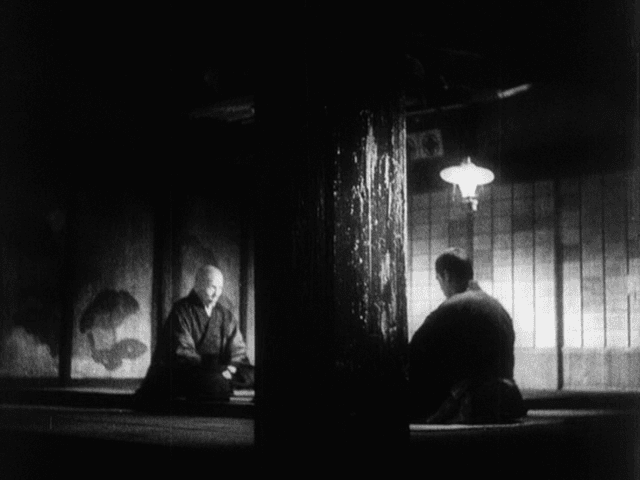
They eventually meditate. Framed against a backdrop of painted blooming lotus flowers which recall the first movie, Sugata, in a funny dissolve, falls asleep. He awakens to some shame, but when he attempts to apologize he finds the priest has fallen asleep too. Perhaps he realizes that no human can live up to an absolute set of rules, but at this point he sets out for the fight he’s been avoiding.
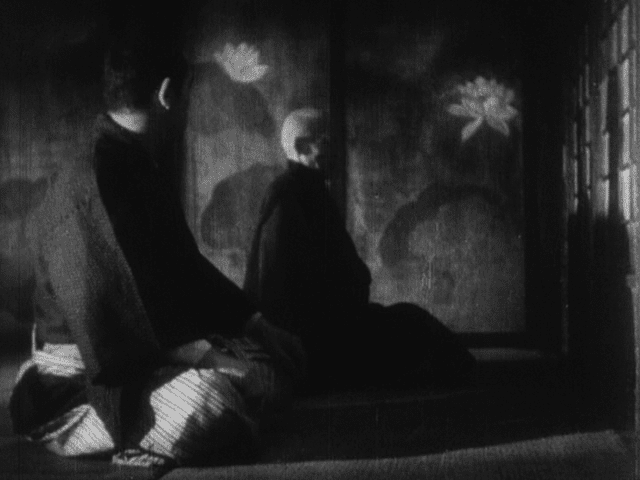
The final duel takes place, again, on a mountain. This time instead of a howling gale, it’s a snowstorm the fight takes place in. It’s yet another callback to the first film. Tesshin and Sugata face off, barefoot in the snow, while Gunzaburo is sidelined after a seizure. The result is about a 5 minute epic karate vs. judo duel complete with a tree being cut down with a karate chop. While the film has little of the emotional impact and meaning of the first one, Kurosawa is still able to deliver an epic climax. There’s an important coda with Gunzaburo’s reaction to the fight and Sugata’s spirit.
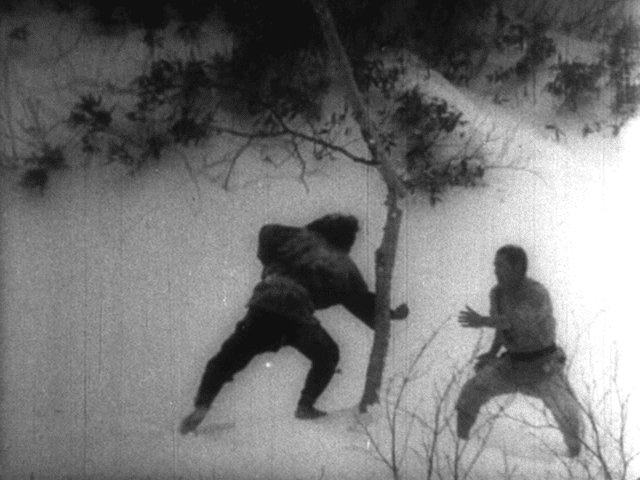
As entertainment, Sanshiro Sugata Part 2 shrugs off its propaganda and slow start to deliver a lot of technical high points and thrills. But it’s hopelessly compromised from being art. Kurosawa was disinterested, but I don’t know if he could have delivered much more even with real interest. There’s just no story to tell after Sugata’s growth in the last film. And Sugata, with his struggle to find the most honorable way instead of struggling between honor and impulse, just isn’t as fun and likable a character. He’s too noble for his own good this time around. At its best, it’s a pale shadow of the first film and relies on the first film to provide it any meaning. It’s essentially a remake of the first film, only
bigger. It’s a typical sequel in many ways.
It’s pretty much impossible to tell how it played in Japan upon its release. So many theaters were bombed in the meantime that it was barely seen. The very reasons for making the film in the first place, WWII, ironically prevented it from being of any use.
Kurosawa though delivered what the authorities wanted. And he was given his next assignment, adapting a famous traditional story of Noh and Kabuki. It’s Kurosawa’s first samurai movie as well. I’ll look at the results next month.
Next Month: THE MEN WHO TREAD ON THE TIGER’S TAIL (1945)